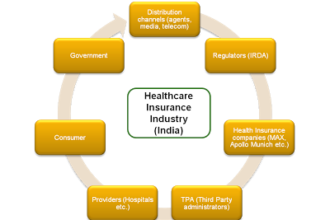Over the past couple of years, a lot of attention has been placed on our health care system. The Centers for Medicare and Medicaid Services projects that, by 2020, national health care expenditures will reach $4.638 trillion — almost twice of what it is today.
Over the past couple of years, a lot of attention has been placed on our health care system. The Centers for Medicare and Medicaid Services projects that, by 2020, national health care expenditures will reach $4.638 trillion — almost twice of what it is today.
The passing of the controversial $787 billion American Recovery and Reinvestment Act (ARRA) in 2009 brought the subject of Medical Informatics to the forefront, among both consumers and health care professionals. The law provides $19 billion for health care companies to implement information technology systems such as Electronic Health Record (EHR), in order to make the industry more efficient. This is better known as Title XIII, the Health Information Technology for Economic and Clinical Health Act (HITECH).
The Healthcare Information and Management Systems Society (HIMMS) defines Electronic Health Record (EHR) as:
A longitudinal electronic record of patient health information generated by one or more encounters in any care delivery setting. Included in this information are patient demographics, progress notes, problems, medications, vital signs, past medical history, immunizations, laboratory data and radiology reports. The EHR automates and streamlines the clinician’s workflow. The EHR has the ability to generate a complete record of a clinical patient encounter – as well as supporting other care-related activities directly or indirectly via interface – including evidence-based decision support, quality management, and outcomes reporting.
There are three major areas in the field of health care information technology:
- Health Information Management: documentation, proper coding for billing, legalities, and information architecture.
- Information Technology: routers, servers, software implementation, databases, and infrastructure architecture.
- Informatics: turning data into information, and information into knowledge — systems thinking
With a combined total of $33.254 billion in federal funding from various sources for health care IT, it would be an understatement to say that the passing of the ARRA started a “frenzy” among health care providers to implement IT systems in order to comply with the requirements set forth in this legislature, and to take advantage of such federal funds.
You may frequently hear the term “meaningful use” among the leadership of various health care organizations, as this is the framework that the U.S. Health and Human Services department has put together. Health care organizations must demonstrate the meaningful use of health information technology, in order to comply with the requirements set forth in HITECH, which are conditional any federal funds the organization received under this act.
Even though the ARRA has been very much criticized and polarized, the HITECH portion of the act has effectively created market vectors that positively impact various segments of the IT industry: software companies, hardware manufacturers, telecommunications companies, consulting firms, and others.
Many experts have spoken about the potential impact of modern information technology systems in the health care field, for example, an article from RAND stated in 2005 that “the potential efficiency savings for both inpatient and outpatient care could average over $77 billion per year,” an OP-ED from Forbes just a few months ago also stated that “state-of-the art technology was going to drastically lower [health care] costs — on the order of $80 billion a year.”
Three major technologies to keep an eye on in health care IT: (1) enterprise mobility, (2) cloud computing and storage, and (3) decision-support systems.
Now, there is no question that the health care and IT has a bright future, and an enormous potential to improve quality of care and reduce operational costs, but it also raises the question of whether current IT professionals are prepared to handle the unique intricacies of health care. Moreover, how do health care organizations source competent talent, and how do they adapt to emerging technologies, like mobile?
The College of Healthcare Information Management Executives, for example, reports in a recent survey (2012) that 67 percent of the respondents state that they are experiencing HIT shortages, retention of HIT staff is also a growing concern, and clinical software implementation experts were the highest in demand.
As such, major universities across the country have created programs to respond to these needs, collectively known as Medical Informatics or Biomedical Informatics. Below is a small sample of top academic programs across the country (in no particular order):
- Nova Southeastern University (where I am a student) – Fort Lauderdale, FL
Focus areas: Public Health, Nursing, Medicine
Delivery: Fully online, Hybrid, On Campus
Cost of Attendance (approx.): $11,755 for Certificate Program, $27,675 for Masters Program
- Johns Hopkins University – Baltimore, MD
Focus areas: Public Health, Nursing, Medicine
Delivery: Fully online, Hybrid, On Campus
Cost of Attendance (approx.): $19,383 for Certificate Program, $44,100 for Masters Program
- Stanford University – Stanford, CA
Focus areas: Medicine, Biology
Delivery: Fully online, Hybrid, On Campus
Cost of Attendance (approx.): $41,250 for Masters Program
- Columbia University – New York, NY
Focus areas: Public Health, Nursing, Medicine, Biology
Delivery: On Campus
Cost of Attendance (approx.): $15-19K for Certificate Program, $42,584 for Masters Program
- Yale University – New Haven, CT
Focus areas: Medicine, Biology, Science
Delivery: On Campus
Cost of Attendance (approx.): $0 for PhD/Post-Doc (covered by grants and/or institutional funding ONLY)
You may also view a list of universities that have programs funded by the National Institutes of Health, and offer grants for students. Also, the American Medical Informatics Association (AMIA) has a list of programs available at various universities.
After speaking with various academic program directors, it is clear that the goal of Medical Informatics academic programs is to train professionals to effectively use information technology within the clinical setting, essentially bridging the gap between IT and health care. As Harold Lehmann, Health Sciences Informatics Program Director for Johns Hopkins University, put it:
“Information technology can either really improve the quality of care and safety of the healthcare system, or can kill people — that is why medical informatics professionals are needed, they are trained to know clinical workflows inside and out.”







